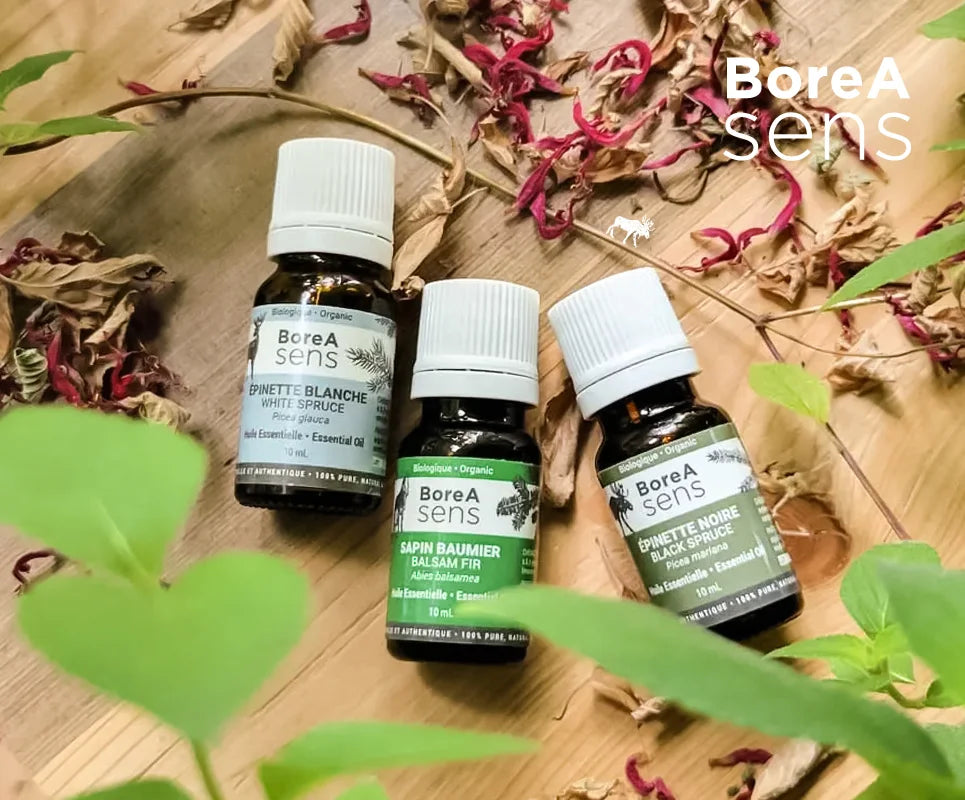
Antibacterial essential oils
Growing antibiotic resistance: a major challenge and the essential oil alternative
The growing resistance of bacteria to antibiotics represents a major global challenge, driving research into the identification of new bio-molecules with broad anti-bacterial activity. Plants and their compounds, such as essential oils, are widely used in traditional medicine.
WHAT ARE THE MAIN CHARACTERISTICS OF ESSENTIAL OILS? ARE THEY REALLY NATURAL ANTIBIOTICS?
Yesss! Essential oils have strong anti-infectious, antiseptic and antiviral properties. They are a proven alternative to antibiotics. What's more, their powers go much further: they are analgesic, healing, anti-hemorrhagic, digestive, regulate immunity and hormones, eliminate infiltrated fats and strengthen blood vessels... Each essential oil has specific roles and, for the most part, multiple activities.
Some essential oils are particularly "antibiotic", although it would be more accurate to call them "antiseptic", because, unlike antibiotics ("against life"), they do not destroy our beneficial flora.
They have been used for their "antibiotic" properties in hot countries, where traditional dishes are very spicy: the essential oils in spices inhibit microbial growth in food. For thousands of years, essential oils have been used as fumigants or rubs. In 1887, Chamberland scientifically proved that essential oils of oregano, clove and cinnamon have antibiotic properties against Bacillus anthracis (the anthrax bacillus), with surprising results.
In aromatherapy, numerous studies have demonstrated the effectiveness of essential oils against common, aggressive microbes such as diphtheria, typhoid and streptococcus. Essential oils can be used to combat a wide range of dreaded germs.
THE MAJOR DIFFERENCES BETWEEN ANTIBIOTIC DRUGS AND ESSENTIAL OILS EXPLAIN THE INTEREST IN ESSENTIAL OILS.
1. No antibiotic resistance: According to the WHO, some antibiotics will no longer be effective in 10 to 20 years' time, due to prolonged use, misuse and overuse. Essential oils, on the other hand, do not lose their effectiveness over time. Their extreme diversity prevents microbes from developing resistance.
2. Antiviral properties: Most essential oils are also antiviral. Their preventive antibiotic effect can prevent superinfections, for example by treating the flu or a cold to prevent bronchitis or sinusitis.
3. Modification of the microbial environment: essential oils disrupt the environment1 of germs, making it difficult for them to survive, as well as disrupting their organic and metabolic processes.
4. Efficacy at low concentrations: Essential oils are effective at blood concentrations much lower than antibiotics, and destroy a large number of different bacteria, unlike traditional antibiotics.
5. Stimulation of the immune response: Essential oils prevent the proliferation of germs while stimulating the immune response, thus preventing the recurrence of disease. Conventional antibiotics, on the other hand, kill both positive and negative bacteria. The same is true for most winter ENT and respiratory ailments. Essential oils offer a fast, effective solution, with no side-effects to antibiotics.
6. Rapid disinfection: Spraying or diffusing essential oils can disinfect a room in less than 10 minutes.
Aromatherapy can also be combined with traditional antibiotics to reinforce their effects and achieve faster, longer-lasting results.
INTERESTING STUDIES ON THE ANTISEPTIC EFFECT OF ESSENTIAL OILS.
Researchers already understand the enormous potential of aromatherapy, and very convincing experiments show that aromatherapy can purify hospital surfaces (floors, tables, beds) and air, reducing the risk of hospital illness ("you catch it on the spot"). They could be used to replace current disinfectants, which are either highly toxic (so toxic that they have to be used without human presence) or only moderately effective, and against which micro-organisms can grow.
1. University of Manchester, UK: Studies show that essential oils can completely disinfect a room (without leaving any living bacteria behind!), including the most worrying micro-organisms such as methicillin-resistant Staphylococcus aureus (MRSA) and other multi-resistant germs such as Pseudomonas aeruginosa, and other enterococci such as the notorious Clostridium difficile, and even E. coli.
2. Mite and mold reduction: Researchers suggest that hospital staff could use the most disinfectant essential oils (shampoos, soaps, body washes, disinfectants, etc.) to stop "epidemics "2. Essential oils eliminate between 57% and 100% of dust mites, moulds, fungi, bacteria and viruses3 in two minutes.
3. Prevention of acute bronchitis: Taken orally, they reduce the number of acute bronchitis attacks in patients with regular bronchitis4.
4. Limiting microbial proliferation in hospitals: They can limit the proliferation of fungi and microbes before their numbers reach thresholds indicating poor air quality5.
SOME EXAMPLES OF ANTI-INFECTIOUS ESSENTIAL OILS:
ESSENTIALS OILS OF QUEBEC6:
- Balsam Fir EO (Abies balsamea) and Black Spruce EO: Antiviral properties, help fight colds and flus.
- White Spruce EO (Picea glauca): Anti-bacterial and immunostimulant properties.
- Common Juniper (Juniperus communis) EO: Antiseptic properties for the renal and urinary tracts.
EO FROM AROUND THE WORLD :
- Oregano EO (Origanum vulgare): Due to its high carvacrol and thymol content, oregano is a powerful natural anti-bacterial agent. It is effective against bacteria that cause respiratory, urinary and skin infections... even multi-resistant strains!
- Tea Tree EO (Melaleuca alternifolia): From an Australian tree, this is an excellent broad-spectrum antibacterial, especially against germs responsible for skin infections such as acne, mycosis, abscesses and boils, as well as mouth ulcers and gingivitis, are relieved by it. It's also the perfect essential oil for fighting winter viruses and germs, such as sore throats and coughs. Its secret lies in the synergy of its active molecules, including Terpinene-4-ol, Gamma-terpinene, Alpha-terpinene and Limonene.
This article offers advice and in no way replaces medical advice or constitutes a prescription. It is not intended to prevent you from consulting your doctor or stopping your treatment.
References
1 - A. Bouyahya et al, "Antibiotic resistance and the mechanism of action of essential oils against bacteria," Phytotherapy, December 2018.
2 - Jacqui Stringer, Clinical Lead of Complementary Therapies at Manchester's Christie Hospital, 2004.
3 - Puressentiel study/spray with 41 essential oils/Souches supplied by Institut Pasteur de Paris.
4 - Étude gouttes aux essences, Pr Dalphin, head of the pneumology department at Besançon University Hospital.
5 - Thesis by Dr. Gisèle de Billerbeck "Microbiological sanitation of air and ventilation systems using essential oils", EPFL 2005.
6 - Nobles essences, guide des plantes aromatiques et huiles essentielles du Québec (STEPHANIE PLAMONDON).
7 - Dominique Laurain-Mattar et al, "Huile essentielle d'Origan vulgaire," Actualités Pharmaceutiques, October 2022.
8 - Dominique Laurain-Mattar, Françoise Couic-Marinier, "Huile essentielle d'Arbre à thé ou de Tea tree," Actualités Pharmaceutiques, February 2019.




